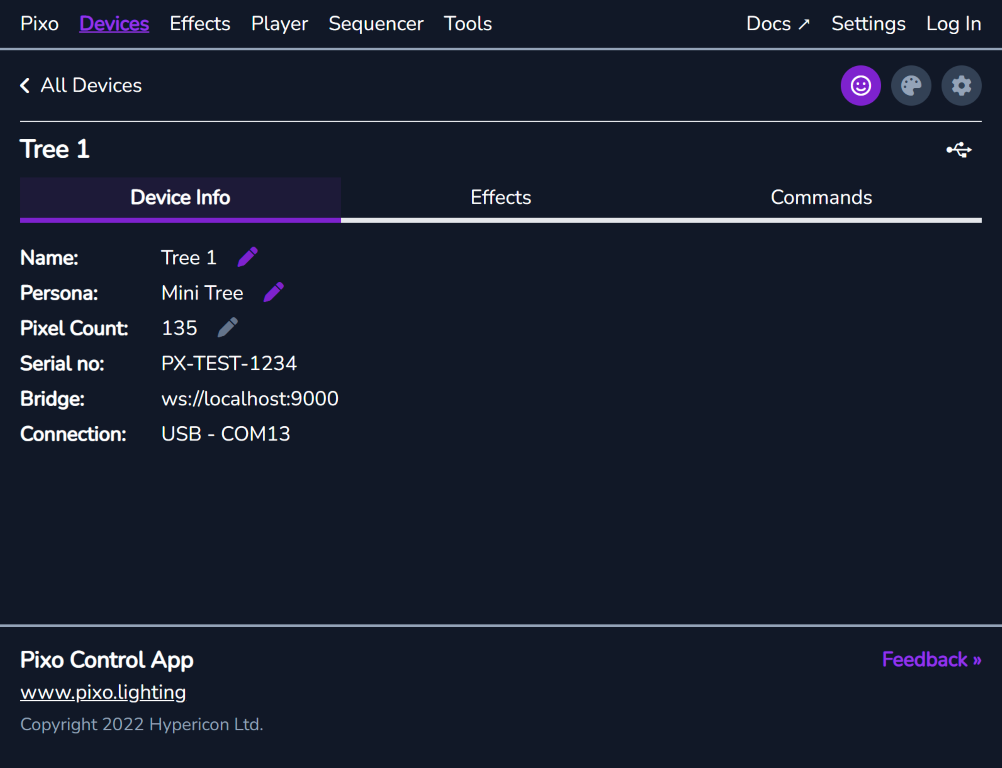Update Device Settings #
Pixo devices have a number of user-ediable settings to configure how they work, and to identify them in a list.
Contents #
Device Settings #
The Pixo device must be connected before you can edit its settings!
In the "Devices" page (click "Devices" in the App header), select the device to edit by simply clicking on it.

Device Detail page
Device Name #
The device name simply sets you identify which device is which. If you only have one device connected, this is of course not important.
You can name you devices in a number of ways:
- by location, e.g. "Top shelf backlight", "Window strings", "Desk glow", etc.
- by part in a sequence, e.g. "Lead Singer", "Backing Singer", "Surrounding String", etc.
As long as your chosen device name contains no restricted special characters, you can name your devices anything you like!
To edit the setting, click the button, then enter the new name in the dialog box.
The device does not need to be rebooted after editing this setting.
Device Persona #
The device "Persona" tells the device what it is. The Pixo firmware contains definitions for a number of layouts of LEDs built-in, so that you can connect a single Pixo LED controller to one of a number of Pixo exhibits.
The persona also enables the Control App to display different settings and options based on the persona of each conencted device. For example, some devices have a "face" of pixels for singing sequences, while others do not.
If your device has a built-in Pixo controller, for example a Mini Singing Tree, you do not need to edit this setting.
To edit the setting, click the button, then select the new persona in the dialog box. For a generic string of pixels of any length, select the persona "Pixo".
You must reboot the device after setting a new value to finish applying the update
Device Pixel Count #
Most device personas define number number of pixels present in the device. Devices wth the "Pixo" persona could be connected to any string of LEDs, or any length.
The Pixel Count setting is used by the device to define how many LEDs are in the conencted string, to make sure that effects are displayed correctly.
To edit the setting, click the button, then enter the new pixel count in the dialog box.
You must reboot the device after setting a new value to finish applying the update
Bridge Settings #
To edit Bridge settings, first open the "Devices" page (click "Devices" in the App header), then select the "Bridges" tab.
Next, click the "Edit" button nex to the Bridge you wish to edit. In the vast majority of cases, you will only have one bidge to choose from.
The bridge detail page displays the editable settings, as well as connection information.
Assets Folder #
The Bridge Assets Folder is a special folder on the same computer as the Bridge that the Bridge can access when creating animated lighting sequences (see Sequencer Introduction for more information on the Sequencer).
The Assets Folder is currently mainly used to serve local audio files to the Sequencer.
In upcoming updates, the Bridge will receive the ability to play scheduled sequences while unattended, and this Assets Folder will be used to store the sequence and schedule definitions as well.
To edit the Assets Folder, simply edit the file path in the input then press the button to save the edit.
The Assets Folder setting can be a relative path. It is often very useful to define the assets folder location in terms of the Bridge's location.
For example, if the Bridge executable is located at the path: C:\Users\example\Pixo\pixo-bridge.exe
then an Assets Folder setting of ./bridge-assets (note the leading full stop) will point to the folder: C:\Users\example\Pixo\bridge-assets. The folder will be next to the Bridge executable.
If you are using the Control App on the same computer as the Bridge is running, you can use the button to open the Bridge Assets folder in your computer's file explorer. This is very useful to check the location of the configured Assets Folder, and for organising a number of asset files at once.